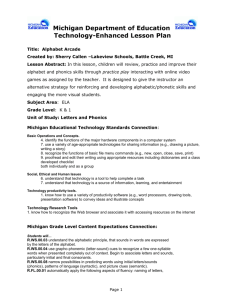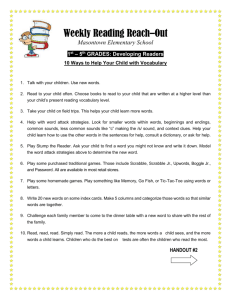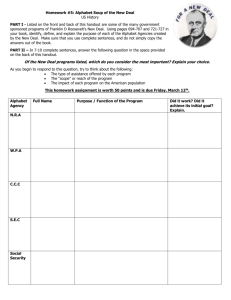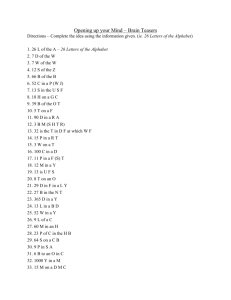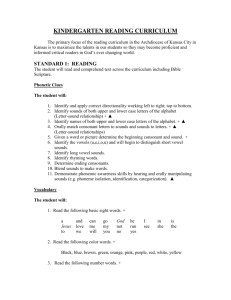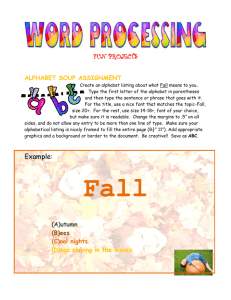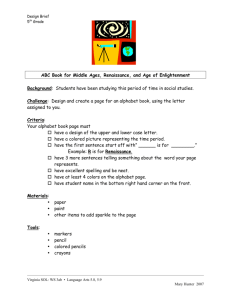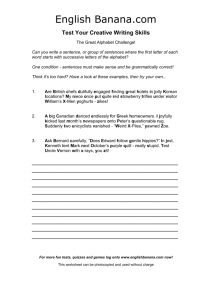Alphabetic Principle - Manor ISD Curriculum
advertisement
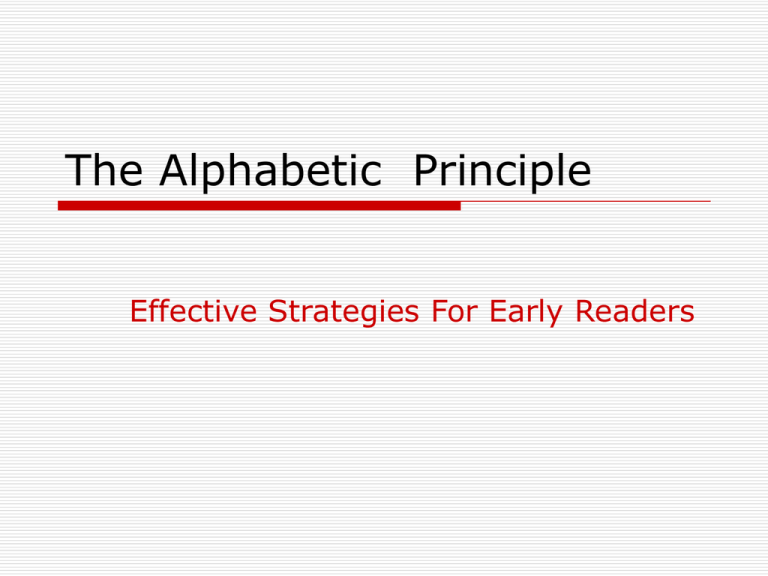
The Alphabetic Principle Effective Strategies For Early Readers Definition The alphabetic principle involves the understanding that letters represent sounds and that the sounds of letters are combined to form words. It is also understood that there is a connection between spoken sounds and written language. The alphabetic principle is the concept that each letter of the alphabet has one or two sounds associated with it and that these letter-sound relationships are stable. This means that children become used to the idea that the B in the name Brent makes the same sound in the words ball, baby, and cab. Why is the Alphabetic Principle important? Research Says: Letter-sound knowledge is prerequisite to effective word identification. A primary difference between good and poor readers is the ability to use lettersound correspondence to identify words (Juel, 1991) Why is the Alphabetic Principle important? Research Says: The combination of instruction in phonological awareness and lettersounds appears to be the most favorable for successful early reading (Haskell, Foorman, & Swank, 1992) Good readers must have a strategy to phonologically recode words (Ehri, 1991; NRP, 2000) Why is the Alphabetic Principle important? Research Says: As children begin to read they must develop knowledge of how print works. Key to this understanding is knowledge of the alphabetic system. In order for children to successfully learn to read they must be able to relate the sounds of language with the letters of written language. The alphabetic principle is often regarded as the biggest obstacle preventing children from learning to read. (Snow, C.E., Burns, M.S., & Griffin, P. , 1998) Teaching the Alphabetic Principle: Critical Alphabetic Principle skills students should learn: Letter-Sound Correspondences Sounding Out Words Reading Connected Text Letter-Sound Correspondences An excellent source for learning lettersound relationships in the Emerging Reading Phase is the use of Alphabet Flash cards that show letters of the alphabet and corresponding pictures. Pictorial representations of a letter and sound help the child to establish letter/sound correspondence Example: (Teacher points to letter m on board). "The sound of this letter is /mmmmm/. Tell me the sound of this letter.“ Letter-Sound Correspondences The Alphabet Song Sing the alphabet song on a regular basis but vary the ways that you do this. For example: point to the letters of the alphabet as children sing. vary the speed at which you sing. sing the alphabet backwards sometimes. tell the children to watch you and stop singing whenever you stop moving the pointer. Ask, "What letter did I stop on?" Letter-Sound Correspondences The Alphabet Song Variations: Demonstrate singing the sounds that the letters make instead of singing the names of the letters. Another variation would be to sing a short vowel with each consonant, asking children to not sing the other vowels when they come to them. For example when using the 'short a' sound, sing "A, ba, ca, da, __, fa, …" and so on. Letter-Sound Correspondences Alphabet Games Pass out your laminated alphabet cards--one per child. Display any that are left over on the board ledge… Sing the alphabet song slowly. Each child stand up when her/his letter is sung. Distribute the cards randomly whenever you repeat this activity so that no child is always A or always Z. Letter-Sound Correspondences Instructional Design Considerations Teach tasks explicitly. Introduce continuous sounds early on (IE. /mmmm/). Practice letters that sound and look familiar. (b & d) Introduce common letters early to allow students to form as many words as possible. Introduce lower case letters first. Build learned letters into new, more complex letter configurations. Use a distributed review cycle to build retention: NKNKKNNKKKKN (New Sound, Known Sound) Examples of Tasks Illustrating Alphabetic Understanding Letter-sound associations: What is the sound of this letter? Soundblending: Blend the sounds of these letters to make a word /mmmmmaaaaaappp/. Segmenting: What sounds do you hear in this word? Manipulating letter-sound correspondences in words: What word would you have if you change the /n/ in /nap/ to /l/? Reading pseudowords: What is this word, mip? Word identification: What is this word, map? Alphabet Activities Alphabet Arch Alphabet Tracking Strip Font Sorts and Matching Capital and Lowercase letters Letter and Word Hunts Name Games: "Who has this Letter in their Name?"( use pictures) Sensory Exploration of Letters (sandpaper letters, felt letters, magnetic letters, sand, clay etc,) Letter Of The Week Routines In each group, which words begin with the "M m" sound? Which word has a different sound at the beginning? What sound does it begin with? mail, milk, book Which words in these sentences begin with the "M m" sound? Melissa put money in her piggy bank. Play a Word Guessing game. Your answers should begin with the "M m" sound. a. What is white, good to drink, and comes from a cow? _______ (milk) b. What does a cat say? _______ (meow) Make a list of friends, relatives and favorite storybook characters with a name that begins with the "M m" sound.
